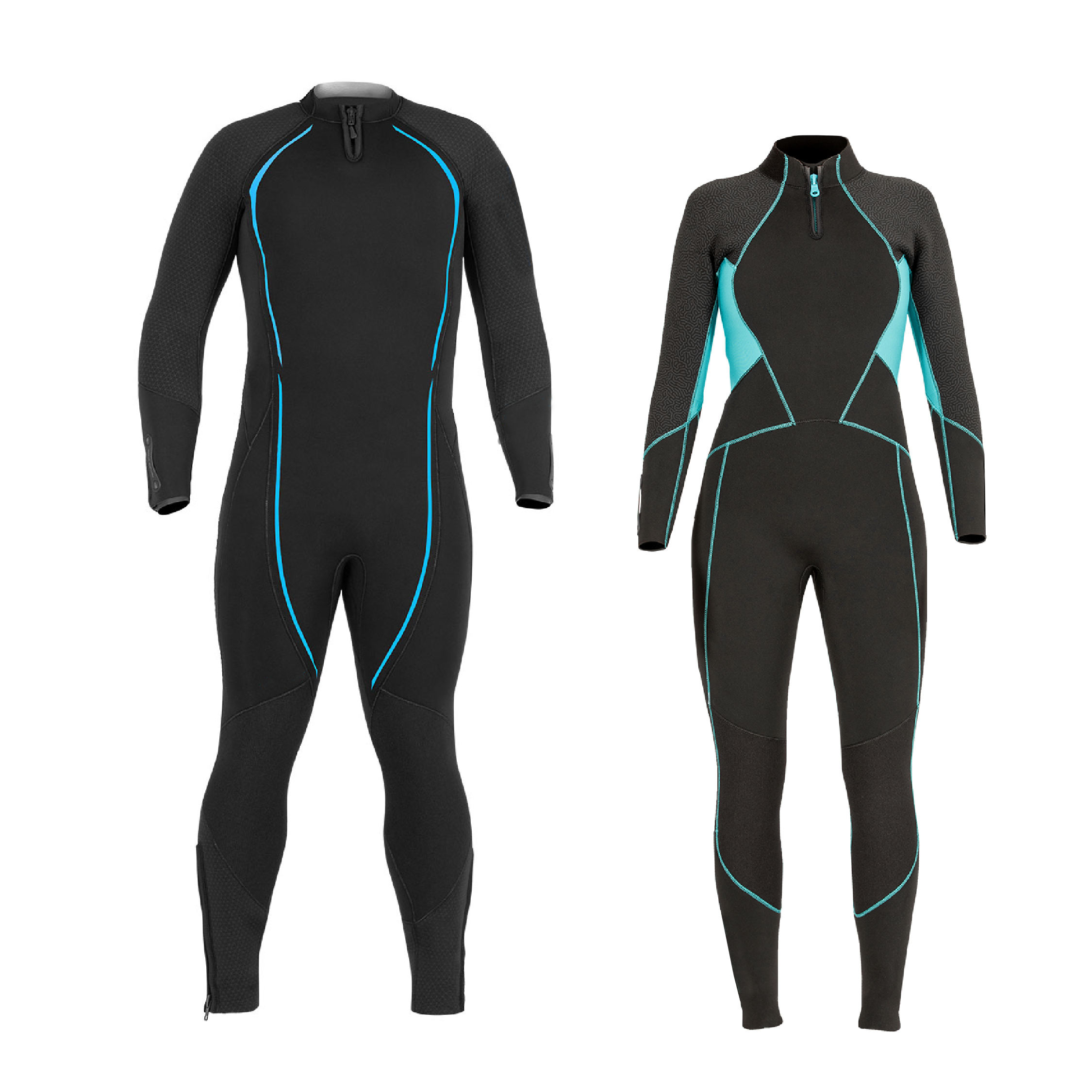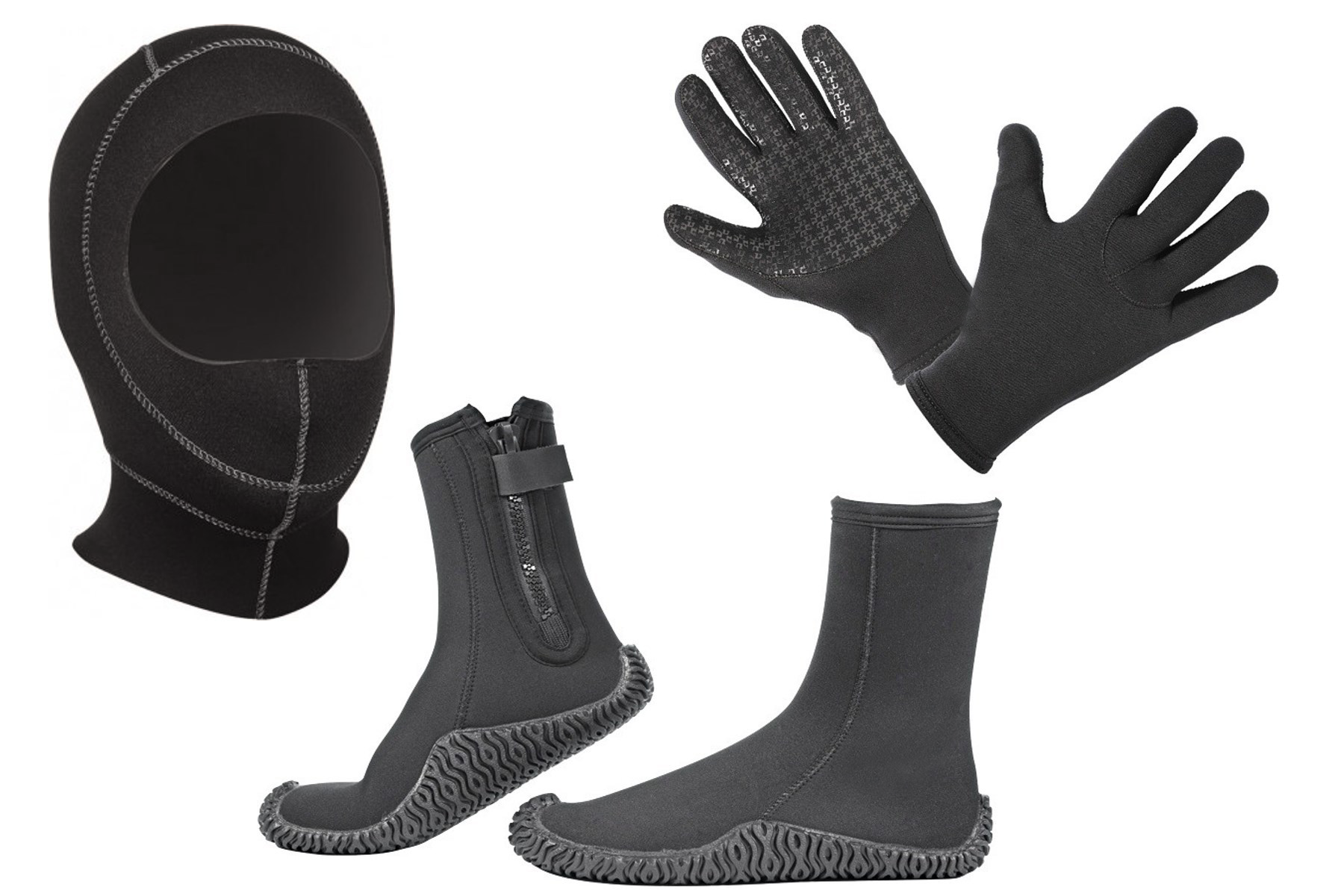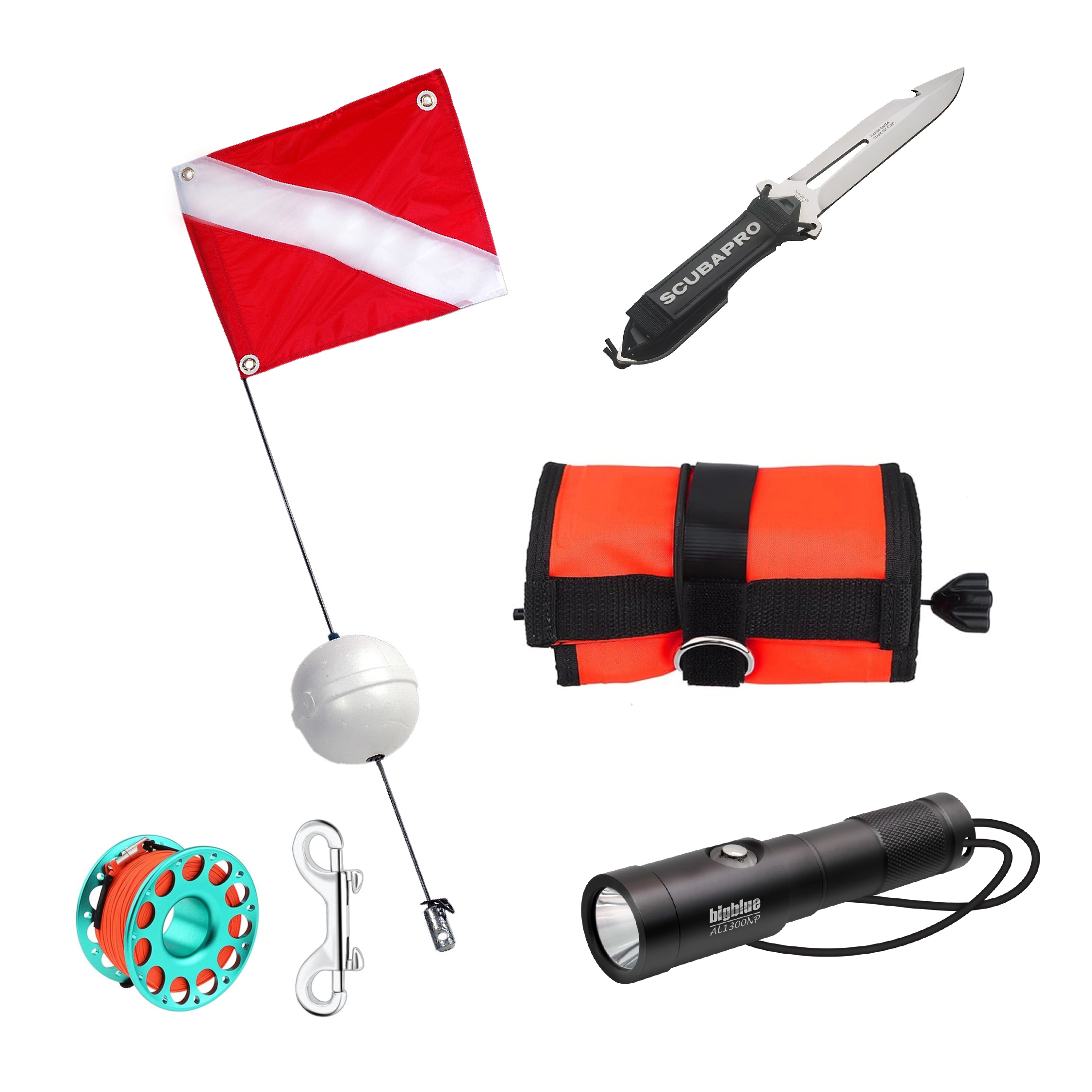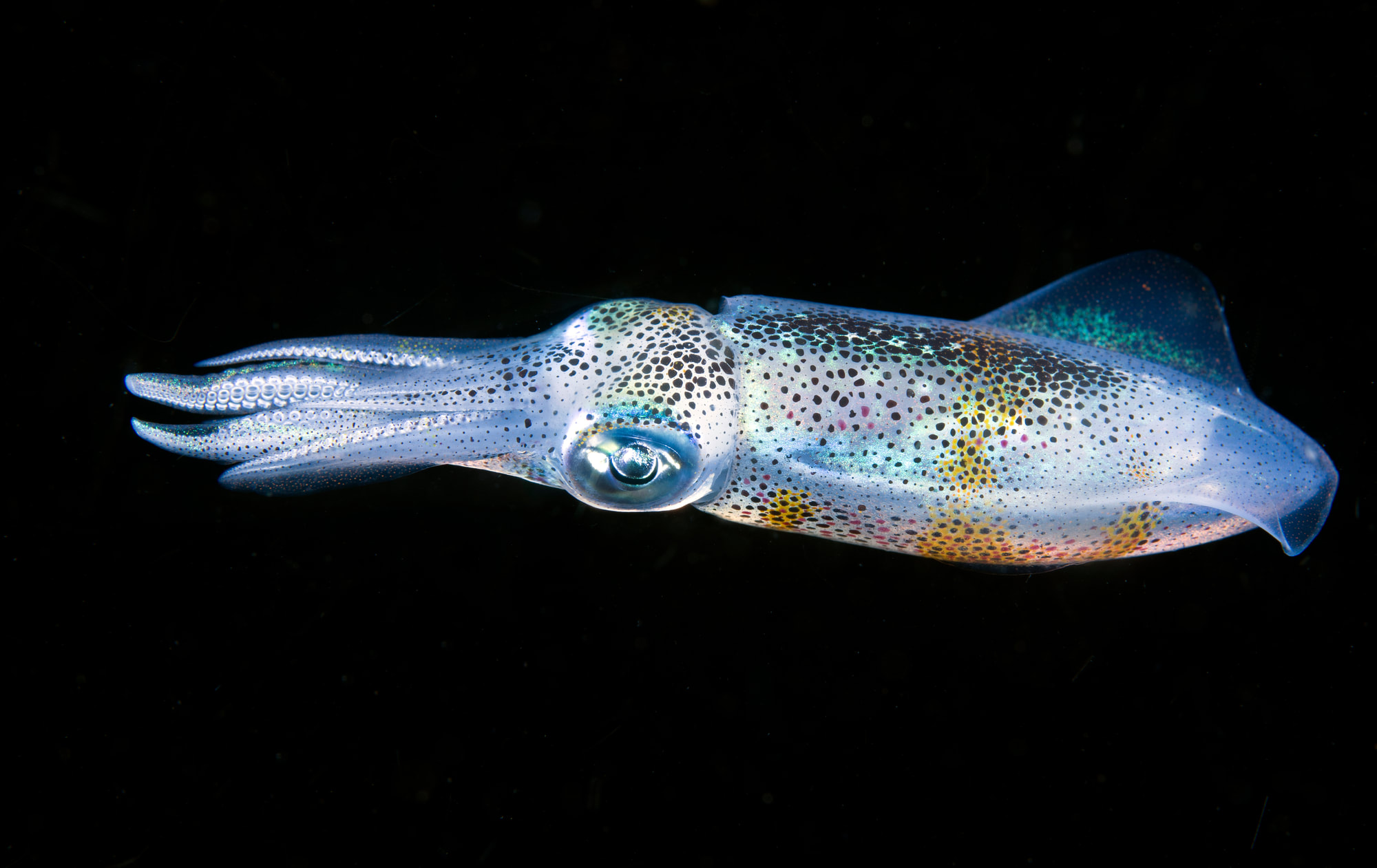Gear up for New England Diving

The New England SCUBA diving experience is different than warm water diving. Dives in New England may impacted by cool/cold water temperatures, low visibility, cool/cold/hot air temperatures and tides to name several factors.
New England water temperatures may range from 33-72°F throughout the year, requiring a diver to consider gear adjustments. Properly fitted gear that has been designed for a dive's minimum water temperature is a key factor to an enjoyable and safe dive.

Exposure Suit Options
-
-
A wetsuit is a positively buoyant neoprene garment that divers use while SCUBA diving. Wetsuits are designed to be snug, but allow for a thin layer of water to flush through the suit that is warmed by the diver's body. This heating process keeps the diver warm.
While wetsuits are used globally, the thickness of the wetsuit used will differ in warm water than cold water. In New England where the warmest waters (late summer) range from 50°F-72°F, depending on location, most divers use a thicker, full-body, 7-8mm wetsuit if not using a semi-dry suit or a dry suit. Divers who run warm will find themselves in a 5mm wetsuit, especially if diving in "warmer" water locations like Dubois beach (CT) or Ft Wetherill (RI).
Material: Wetsuits are made out of neoprene.
Wetsuit thickness is measured in millimeters (mm). Suits range from 1mm to 8mm (with 1mm being thinner and 8mm being thicker)Season: Wetsuits are generally used from May through October in New England
-
-
-
A semi-dry suit is a positively buoyant neoprene garment that divers use while SCUBA diving. Semi-dry suits are designed to be snug and have seals located on the wrists, ankles and neck that further decrease the amount of water that circulates in the suit. There is enhanced zipper technology to prevent water from entering the suit through the zipper. As there is less water in the suit, the body does not have to consistently warm up new water. This heating process along with the decreased amount of water flushing through the suit, usually keeps the diver warmer than a wetsuit if properly fitted.
An add-on feature available with the semi-dry suit is to have an integrated hood, a hood fully attached to the suit. Some divers swear this keeps them warmer, while others say it's a pain to have it integrated.
Semi-dry suits are not commonly seen in warmer water dive locations. In New England it's common to see divers in a 7-8mm semi-dry suit, and while rare, we sometimes see this being worn during the winter. Brr.
Material: Semi-dry suits are made out of neoprene. Wetsuit thickness is measured in millimeters (mm). Suits range from 1mm to 8mm (with 1mm being thinner and 8mm being thicker).
Season: Semi-dry suits are generally used from April through November in New England.
-
-
-
A dry suit is a garment that divers use while SCUBA diving that keeps the majority of the body dry. Dry suits offer limited, if any, insulation. These suits are designed to be fitted with room for insulated undergarments for warmth. Dry suits are airtight with latex or silicone seals located on the wrists and neck and have zippers that do not allow for water to enter the suit. There are no ankle seals as the diver's legs and feet are fully incased in the suit. Because there is no water in the suit, the body relies on the undergarments to maintain warmth. A dry-suit is also equipped with valves that allow for air to enter and exit the dry suit. The air in the suit prevents suit squeeze during the diver's descent and in cases helps maintain a diver's buoyancy.
An add-on feature available with the dry suit is to have integrated boots that are fully attached to the suit. Some divers like that it's in one piece while others purchase rock shoes (or even converse shoes as a great alternative.) Another optional add-on feature is the dry glove system that do just as they say, keep your hands fully dry.
Dry suits are not as commonly used in warmer water dive locations, but in New England where the warmest waters (late summer) range from 50°F-70°F, and the coldest waters (late winter) range from 33°F-45°F, depending on location, it's frequent to see divers in dry suits all year round. Dry suits require additional training to the open water or advanced courses. It's recommended that divers take the dry suit course before attempting to dive with a dry suit.
Material: Dry suits can be made from a trilaminate design or crushed neoprene. Trilaminate is usually lightweight and foldable. Crushed neoprene is thicker and heavier. Trilaminate is considered a shell since it does not provide insulation. Crushed neoprene provides a bit of insulation.
Season: Dry suits are generally used throughout the year in New England.
-

Exposure Suit Accessories
-
-
There is the standard neoprene glove that fits snuggly around the hand to allow for some dexterity, there is a semi-dry glove that has wrist seals to limit the water flow, and there is a three finger mitt that some divers jokingly refer to as the lobster glove. There is also a dry glove system that can be paired with a dry suit.
-
-
-
Wetsuit divers or Semi-dry suit divers will use neoprene boots. It's recommend you have a good grip on the bottom for those rocky (and sometimes quite slippery) shore dives. Dry suit divers will either have their boots built into the dry suit system or purchase rock boots or converse sneakers.
-
-
-
There is the standard neoprene hood that fits snuggly to minimize water flow. While most divers have 7mm or 8mm hoods, there are divers that are fine with 5mm. Some hoods come with valves designed to eliminate any lingering air pockets during a dive. While vents can also be added to hoods, not everyone finds they need a valve in their hood.
-

Safety Accessories
-
-
In parts of New England, flags are required to be used during dives. Flags are kept on the surface of the water through various flotation devices that are connected to a hand-operated dive reel. Divers will use this flag so boaters know to slow down. Each state has their own regulations. [View the flag regulations by state](/regulations). Unfortunately, not all boaters stay a safe distance from dive flags so always exercise caution when there are boats in the area.
-
-
-
Diving in New England can sometimes offer low visibility. While diving during low visibility conditions, you will want to remain extra close to your dive buddy. It is a good idea to carry an easily accessible narrow beam light with high lumens to signal to your dive buddy. It's even safer to carry an extra just in the event your primary flashlight malfunctions when it's needed.
-
-
-
For New England shore dives and boat dives, there can be decent currents. A SMB, Surface Marker Buoy, is a great safety tool to carry in the event you get caught in a current and can't get back to shore or the boat.
-
-
-
Imagine there is low visibility and you're diving on a New England wreck dive in 100 ft of water. Having a strobe on the ascent/decent line on the wreck may make it much easier to find as the strobe flashes a bright light that can assist greatly with navigation.
-
-
-
Make sure that if you get tangled in fishing line, you have a cutting device to get yourself free. We recommend shears and a knife.
-
Dive shops across New England provide the best advice on dive gear for you to enjoy our local waters.

Did you know humans cool more quickly during immersion in cold water , compared to when they are exposed to air at the same temperature? (Castellani, 2016)
Did you know there are physiological changes divers can experience in cold waters such as impaired of sensation of hands or toes, increased breathing rhythms, and possible hypothermia? Yes we've seen this, and the correct gear will reduce risk.
Did you know temperatures in New England can range from 33-72°F depending on location? Rhode Island and Connecticut normally provides warmer conditions than Maine and New Hampshire. Summer months normally grant warmer conditions than winter. Dive profile maximum depth will likely impact water temperature.
Castellani, J W. and Young, A J. (2016) Human physiological responses to cold exposure: acute responses and acclimatization to prolonged exposure. https://doi.org/10.1016/j.autneu.2016.02.009

